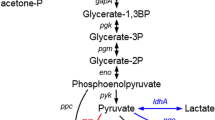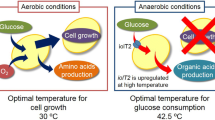In order to test the temperature sensitivity of glutamate production metabolism, several temperature shifts, from 33 to 37, 38, 39, 40 or 41°C, were applied to the temperature-sensitive strain, Corynebacterium glutamicum 2262, cultivated in a 24-h fed-batch process. Whereas glucose was entirely dedicated to biomass synthesis when cells were grown at 33°C, applying temperature upshocks, whatever their range, triggered a redistribution of the carbon utilisation between glutamate, biomass and lactate production. Although increasing the culture temperature from 33 to 37, 38, 39 or 40°C resulted in final glutamate titers superior to 80 g/l, temperatures resulting in the best chanelling of the carbon flow towards glutamic acid synthesis were 39 and 40°C. Moreover, this study showed that the higher the temperature, the slower the growth rate and the higher the lactate accumulation. Journal of Industrial Microbiology & Biotechnology (2002) 28, 333–337 DOI: 10.1038/sj/jim/7000251
Similar content being viewed by others
Author information
Authors and Affiliations
Additional information
Received 26 September 2001/ Accepted in revised form 23 February 2002
Rights and permissions
About this article
Cite this article
Delaunay, S., Lapujade, P., Engasser, J. et al. Flexibility of the metabolism of Corynebacterium glutamicum 2262, a glutamic acid-producing bacterium, in response to temperature upshocks. J Ind Microbiol Biotech 28, 333–337 (2002). https://doi.org/10.1038/sj/jim/7000251
Issue Date:
DOI: https://doi.org/10.1038/sj/jim/7000251




